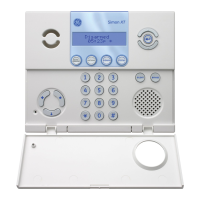Chapter 4
Programming
37
7. Enter the desired end time by entering the hours, minutes, and AM/PM (press Enter after
programming each part).
8. Press Status repeatedly to exit.
Housecode. To change the housecode, do the following:
1. Enter the System programming menu.
2. Scroll up/down to Light control, then press Enter.
3. Scroll up/down to Housecode, then press Enter.
4. The current option value (A to O) now flashes.
5. Scroll up/down to the desired value, then press Enter.
6. Press Status repeatedly to exit.
Sensor-activated light lockout time. Each light (unit numbers 1 to 8) that has been tied to a sensor can be
programmed not to turn on during a certain time of day.
To program the lock interval, do the following:
1. Enter the System programming menu.
2. Scroll up/down to Light control, then press Enter.
3. Scroll up/down to Lock interval, then press Enter.
4. Scroll up/down to the unit number for which you want to program a lockout time, then press Enter.
5. The current option value now flashes.
6. Program the start and end times (see Light schedules on page 36).
7. Press Status repeatedly to exit.
Ethernet configuration
The current panel IP address, current router IP address, current subnet mask, and MAC address are read-only
network parameters that provide you with information about the configuration of the panel on your local
Ethernet network. To read these parameters, enter the System programming menu, select the Ethernet
configuration submenu, and then scroll to the appropriate option.
GSM configuration
The manufacturer, model, software revision, and serial number of the GSM modem, as well as the current
GSM network operator, signal strength (RSSI), error rate (BER), GSM network status, and PUK status are
read-only GSM parameters that provide you with information about the optional GSM module in the panel. To
read these parameters, enter the System programming menu, select the GSM configuration submenu, then
scroll to the appropriate option.
The GSM signal strength is also indicated in system status by the number of solid bars (filled rectangles)
shown. Three or more bars (an RSSI level of 16 to 31) indicate a very good or excellent signal, and one bar or
less (an RSSI level of less than 10 or equal to 99) indicates a weak signal.

